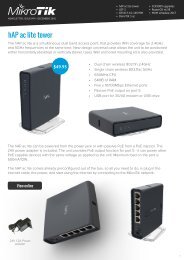fortigate-ipsec-40-mr3
fortigate-ipsec-40-mr3
fortigate-ipsec-40-mr3
Create successful ePaper yourself
Turn your PDF publications into a flip-book with our unique Google optimized e-Paper software.
How this guide is organized Introduction<br />
Redundant VPN configurations discusses the options for supporting redundant and<br />
partially redundant tunnels in an IPsec VPN configuration. A FortiGate unit can be<br />
configured to support redundant tunnels to the same remote peer if the FortiGate unit has<br />
more than one interface to the Internet.<br />
Transparent mode VPNs describes two FortiGate units that create a VPN tunnel between<br />
two separate private networks transparently. In transparent mode, all FortiGate unit<br />
interfaces except the management interface are invisible at the network layer.<br />
Manual-key configurations explains how to manually define cryptographic keys to<br />
establish an IPsec VPN tunnel. If one VPN peer uses specific authentication and<br />
encryption keys to establish a tunnel, both VPN peers must use the same encryption and<br />
authentication algorithms and keys.<br />
IPv6 IPsec VPNs describes FortiGate unit VPN capabilities for networks based on IPv6<br />
addressing. This includes IPv4-over-IPv6 and IPv6-over-IPv4 tunnelling configurations.<br />
IPv6 IPsec VPNs are available in FortiOS 3.0 MR5 and later.<br />
L2TP and IPsec (Microsoft VPN) explains how to support Microsoft Windows native VPN<br />
clients.<br />
GRE over IPsec (Cisco VPN) configurations explains how to interoperate with Cisco VPNs<br />
that use Generic Routing Encapsulation (GRE) protocol with IPsec.<br />
Protecting OSPF with IPsec provides an example of protecting OSPF links with IPsec.<br />
Auto Key phase 1 parameters provides detailed step-by-step procedures for configuring<br />
a FortiGate unit to accept a connection from a remote peer or dialup client. The basic<br />
phase 1 parameters identify the remote peer or clients and support authentication<br />
through preshared keys or digital certificates. You can increase VPN connection security<br />
further using methods such as extended authentication (XAuth).<br />
Phase 2 parameters provides detailed step-by-step procedures for configuring an IPsec<br />
VPN tunnel. During phase 2, the specific IPsec security associations needed to<br />
implement security services are selected and a tunnel is established.<br />
Defining VPN security policies explains how to specify the source and destination IP<br />
addresses of traffic transmitted through an IPsec VPN tunnel, and how to define a<br />
security encryption policy. Security policies control all IP traffic passing between a source<br />
address and a destination address.<br />
Hardware offloading and acceleration explains how to make use of FortiASIC network<br />
processor IPsec accelerated processing capabilities.<br />
Monitoring and troubleshooting provides VPN monitoring and testing procedures<br />
Where possible, this document explains how to configure VPNs using the web-based<br />
manager. A few options can be configured only through the CLI. You can also configure<br />
VPNs entirely through the CLI. For detailed information about CLI commands, see the<br />
FortiGate CLI Reference.<br />
IPsec VPNs for FortiOS 4.0 MR3<br />
12 01-434-112804-20120111<br />
http://docs.fortinet.com/



